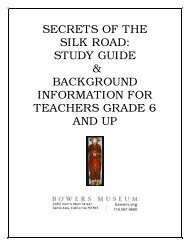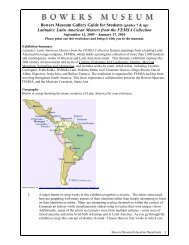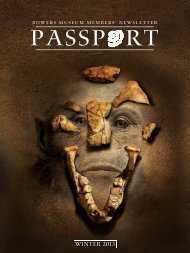A Resource Guide for Students and Teachers - Bowers Museum
A Resource Guide for Students and Teachers - Bowers Museum
A Resource Guide for Students and Teachers - Bowers Museum
Create successful ePaper yourself
Turn your PDF publications into a flip-book with our unique Google optimized e-Paper software.
weapons. Each warrior is a few inches<br />
larger than real life.<br />
The warriors are arranged in<br />
the pits to protect the emperor from<br />
anyone who invades his tomb. Each<br />
pit lies 15 to 20 feet below current<br />
ground level <strong>and</strong> was constructed<br />
with the figures placed in corridors<br />
separated by earthen walls. Pit<br />
number 1 is the largest pit. It is 252<br />
yards long <strong>and</strong> 68 yards wide with<br />
nine corridors which are about 11’<br />
4” wide. The ceilings were made<br />
of large tree trunks which rested<br />
on the partitions <strong>and</strong> outer rims.<br />
Ancient halberd<br />
They were rein<strong>for</strong>ced by planks <strong>and</strong><br />
wooden pillars. A layer of matting<br />
was placed on the planks <strong>and</strong> then<br />
sealed by a layer of plaster over which<br />
was stamped earth. All but the earth<br />
<strong>and</strong> plaster has disintegrated. The<br />
corridors are paved with pottery bricks<br />
on which the warriors <strong>and</strong> horses<br />
st<strong>and</strong>. There are five ramps on each<br />
end leading down to the pit.<br />
The warriors in Pit 1 are arranged<br />
in regular army <strong>for</strong>mation. In the<br />
front are three rows of st<strong>and</strong>ing<br />
archers with crossbows so that while<br />
one row was firing, the others were<br />
reloading. These wore no armor. The<br />
armored infantry line the corridors<br />
with spears, halberds, <strong>and</strong> battle axes.<br />
These are led by officers on chariots<br />
carrying the bell <strong>and</strong> drum used<br />
to give orders during battle. Troops<br />
are defended at the sides <strong>and</strong> rear<br />
by archers <strong>and</strong> crossbowmen facing<br />
outwards.<br />
The positions of the bodies <strong>and</strong><br />
h<strong>and</strong>s of the warriors tell the type<br />
of weapons they used, although<br />
most of the original weapons were<br />
deteriorated. Their uni<strong>for</strong>ms tell their<br />
army position. The<br />
soldiers<br />
wore padded<br />
coats fastened<br />
with a leather<br />
belt with a<br />
hooked buckle<br />
<strong>and</strong> knee length<br />
trousers. They<br />
wore flat shoes<br />
tied to their feet.<br />
The horsemen,<br />
in Pit 2, wore short<br />
tunics over tight<br />
pants. Armor was made in overlapping<br />
plates probably made of lacquered<br />
leather representing fish scale designs.<br />
The cavalrymen wore light armor,<br />
<strong>and</strong> they wore a cap of leather.<br />
Officers wore more ornate armor <strong>and</strong><br />
headgear. The infantry wore boots,<br />
some with upturned toes. Although<br />
the colors on the warriors’ uni<strong>for</strong>ms<br />
have since faded, they were very bright<br />
<strong>and</strong> mixed. Color did not signify rank,<br />
so the final effect was a dazzling array<br />
of a real army of individual people.<br />
One can almost perceive<br />
movement by the positions of the<br />
warriors <strong>and</strong> tilt of their heads.<br />
Not only their<br />
uni<strong>for</strong>ms but their scarves,<br />
tassels, bows, accessories, <strong>and</strong><br />
hairstyles tell their rank so they<br />
can be seen by other soldiers, <strong>and</strong><br />
un<strong>for</strong>tunately also by the enemy.<br />
There are no female figures because<br />
women were not allowed in the<br />
Chinese army.<br />
The faces of the warriors are<br />
all different. Art historians had not<br />
believed that such natural features<br />
appeared in Chinese art until long<br />
after the Qin dynasty. They have<br />
Guard in head armor; armor made of pieces of<br />
limestone secured by bronze thread<br />
been astonished at the expressiveness<br />
of their faces. One feels that this<br />
exhibit is not about an emperor. Its<br />
importance lies in celebration of the<br />
lives of the individuals who built this<br />
empire.<br />
Not only are there warriors<br />
but chariots <strong>and</strong> their horses are<br />
positioned throughout the rows of<br />
warriors. There are four horses <strong>for</strong><br />
each chariot. The horses’ features are<br />
so true to life that they appear alert<br />
to comm<strong>and</strong>s from their charioteers.<br />
Some of the pieces of the chariots are<br />
actually moveable. They were used<br />
in battle on inspection tours of the<br />
army. The horses with the chariots are<br />
tarpans, small horses which are now<br />
extinct.<br />
In addition to the army <strong>for</strong><br />
protection, the First Emporer had<br />
pits created which contained many<br />
13





